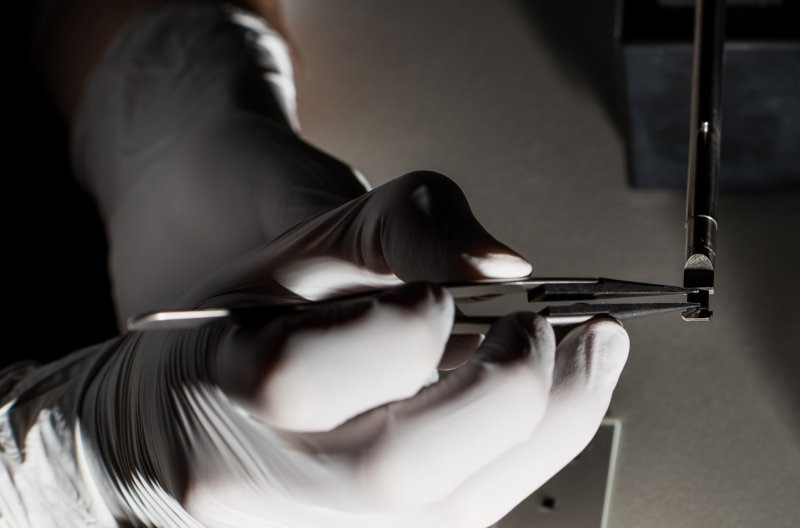Apr 25 2018
A team of engineers and scientists have investigated the mechanisms responsible for degradation of sample quality in liquid cell transmission electron microscopy (LC-TEM). The study has been reported in a new paper published in the Science Advances journal (DOI: 10.1126/sciadv.aaq1202) last week.
The researchers created an LC-TEM device that employs patterned features and multiple windows to probe the effects of high-energy electron bombardment on nanoparticles and sensitive biological samples.
 The research team created a tiny device that allows more of the microscope’s electron beam to pass through liquid samples. (Image credit: Pacific Northwest National Laboratory)
The research team created a tiny device that allows more of the microscope’s electron beam to pass through liquid samples. (Image credit: Pacific Northwest National Laboratory)
The institutions that collaborated for the study are the Environmental Molecular Sciences Laboratory (EMSL), a Department of Energy Office of Science User Facility at the Pacific Northwest National Laboratory (PNNL); University of Illinois Chicago; Florida State University; Washington State University; and Michigan Technological University. Trevor Moser, the lead author of the study who is at present at the PNNL, is a doctoral student at Michigan Tech performing research under both Tolou Shokuhfar, an adjunct professor of mechanical engineering at Michigan Tech and an associate professor of bioengineering at the University of Illinois Chicago, and James Evans, a senior scientist at PNNL.
The researchers have described that transmission electron microscopy (TEM) is dependent on a high-energy beam of electrons passing through a sample. Regardless of whether the sample is from bacterial cells or a battery electrode, the passing electrons get scattered in a particular way, which indicates the atomic structure of the sample. Through LC-TEM, materials can be investigated in their native state enabling dynamic observations; however, the samples are either liquid or suspended in liquid and must be tightly sealed to endure the space-like vacuum of the instrument. A balance must be struck between preventing evaporation of the liquid and ensuring adequate viewing space for allowing passage of the electron beam.
We have designed and fabricated new devices for holding liquid samples which give us more ‘window’ regions to collect images than were previously available. Using these multiple windows, we were able to study how the history of electron irradiation influences the nucleation and growth of silver nanoparticles, the growth properties of which are sensitive to the radicals that are generated with the beam. We also used them to study how these radicals impact bacterial cells and demonstrate the extreme sensitivity of these biological samples to the electron beam.
Trevor Moser, Lead Author
Samples could be physically damaged due to radiation from the high-energy beam employed in LC-TEM. For instance, the researchers discovered that during imaging of a cell - and during exposure of the cell to considerable electron flux for the first time - the resultant nanoparticle movement in relation to the cell membrane was due to cell damage. This is of significance since the insight indicates that the movement is a handiwork of imaging the cell and not the observation of cell dynamics that occur in real time.
“We were able to capture pristine images of cells using our multi-chamber device wherein the first image represented the cells first exposure to significant electron doses,” stated Evans.
Since the native properties of the sample may be altered or changed by the effects of these electron beam-generated radicals, understanding the chemistry changes of a liquid sample as a result of electron irradiation is key to correct interpretation of data collected with this technique.
Tolou Shokuhfar
Once the articulations of LC-TEM are collected, probable applications include gaining exceptionally high-resolution, detailed information related to storage materials and energy device as well as medical imaging, disease detection, and gaining in-depth knowledge of the basics of cell activity. As a future endeavor, the researchers plan to concentrate on characterizing more biological samples, which seem susceptible to the impacts of electron irradiation. The innovative LC-TEM device provides more insights into this complicated atomic world, offering more probabilities for advancements in the areas of health and energy.